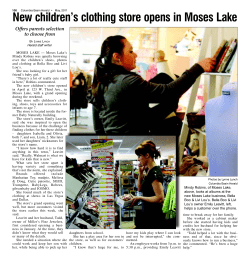
Measurement Uncertainty - How to Calculate It In The Medical Laboratory
Measurement Uncertainty - How to
Calculate It In The Medical
Laboratory
Godfrey C. Moses, PhD, FCACB
National Director, Gamma-Dynacare
Medical Laboratories
11/18/2009
Moses, GC; GDML
1
Introduction
Disclaimers
Procedure that I will be describing is not an approved OLA
method but the contents are based largely on the information in
the 2 OLA documents published in QMP-LS News, as well as on
other peer reviewed publications.
My PowerPoint Presentation “Lacks Power & has no Point!!
11/18/2009
Moses, GC; GDML
2
Objectives
• Brief Introduction on UM concepts
• Overview of available methodology
• Description of the method/procedure used at
GDML
• Some examples from GDML, Ottawa &
Brampton Labs and Dr Lynn Allen’s
• Questions/Discussion as time permits
11/18/2009
Moses, GC; GDML
3
Definitions of Uncertainties
•
UM: A parameter, associated with the result of measurement,
which characterized the dispersion of the values that could
reasonably be attributed to the measurand (the quantity
intended to be measured)
•
U (uncertainty): Parameter obtained from measurements,
which serves, together with the measurement result, to
characterize a range of values for the true value of the
measurand
•
Uncertainty of the Result: Estimated quantity intended to
characterize a range of values which contains the reference
value, where the latter may be either the true value or the
expectation, depending on definition or agreement
Ref EuroLab Technical Report 2006: Guide to Evaluation of Measurement
Uncertainty for Quantitative test Results.
11/18/2009
Moses, GC; GDML
4
UM concepts
•
•
•
•
•
•
Consists of Several Components
Methods for Determining it Consists of Several Steps
One or More and/or Combination of Approaches are Acceptable
Applicable to a Measurement Procedure (Test or Analyte Procedure)
Not to a Series of Replicate Measurements
Steps include
–
–
–
–
Specifying the measurand and the measurement procedure
Defining input quantities and identifying uncertainty sources
Determining & quantifying significant uncertainty sources
Assessing whether correlation exists between contributing sources of
uncertainty
– Calculating the combined standard uncertainty & defining the coverage
factor
11/18/2009
Moses, GC; GDML
5
UM concepts
• Why should medical labs determine UM?
• A. Requirements for Accreditation (Regulatory)
– International standards requiring traceability of lab
results/information to acceptable international reference
(procedure or material)
– JCTLM (IFCC, ILAC & CIPM)
– Manufacturers/Vendors – COA (certificates of analyses) must
state concentration and uncertainty of standards/calibrators.
• B. Quality
– Laboratory services are essential to patient care (ISO
15189:2003); level of performance required for intended use;
UM is another measure of quality
11/18/2009
Moses, GC; GDML
6
UM concepts
•
NPAAC’s (Australia) Summarizes… “ MU is one of the major
potential contributors to the uncertainty of results
interpretation, and laboratories should have such data
available for clinical users”( www.health.gov.au )
•
APLAC’s (Asian-Pacific Lab Accreditation Cooperation) TC 010
(2009)…. “Many important business decisions are based on the
results obtained from quantitative testing. It is important that
an indication of the quality of reported numerical test results is
available to you” (www.aplac.org).
11/18/2009
Moses, GC; GDML
7
Overview of Methodology
….. not a single standardized method; different
approaches are acceptable as long as GUM are
observed….
1. Modeling (equation or algorithm, modeling the
analyte/test as a function of relevant inputs
2. Within or Single Lab Validation QC Data
3. Between or Inter-laboratory Comparison Data
4. Proficiency Testing Data (between lab
comparison with estimate of bias relative to
reference (i.e. Reference value; AMM; AMTM)
5. Combined (2 &4); 3 – 5 Top-Down Alternatives
11/18/2009
Moses, GC; GDML
8
Bottom-up Mathematical Modeling Approach of
GUM
• Function of various inputs
• Mathematically complex equations
• Uncertainty budgets
• Correlations and co-Variances
• Not Suitable for routine use
11/18/2009
Moses, GC; GDML
9
Within/Single Laboratory Validation and QC Data
• Within-Lab reproducibility (imprecision) and
accuracy using suitable reference and QC materials
• Compare lab’s results with those from a reference
procedure run in parallel
Bias = (meanobs – ref)
Imprecision = SDr
= SQRT of Sum (obs - meanobs)
squared divided by (nobs – 1)
11/18/2009
Moses, GC; GDML
10
Inter-laboratory Comparison Data
• Reproducibility SD for labs involved (SDR)
• Test performance conform to standards
• Testing conditions are same in the labs
and/or associated with suitable reference
procedure
11/18/2009
Moses, GC; GDML
11
Inter-Laboratory Comparison for
Proficiency Testing
• Successful Participation in Inter-Lab Proficiency Testing
Program
• Useful in Assessing Bias and Associated UM
– ubias = (RMSyour lab2 + uref2)^0.5 ..ref value given
– ubias = (RMSyour lab2 + SR2/n)^0.5 ..ref value not given
• Combined standard uncertainty
– uc = [SDm2 + ubias2]^0.5
11/18/2009
Moses, GC; GDML
12
Combined Alternative Approach
•
Top-down alternative approach with internal QC and PT Results
•
6-step approach; PT results from EQA (QMP-LS) and DigitalPT
•
MS Excel (1 worksheet each Test selection, Method SD determination;
Bias estimation; UM calculation)
•
Method SD from internal QC; multiple analyzers/modules over six
months
•
Bias and Z-value (SDI, bias/method SD ratio); minimum of 3 surveys
with 2 or more levels per survey
•
Combined and expanded uncertainty of measurement calculated as
absolute and relative (%) values Details about this topic
11/18/2009
Moses, GC; GDML
13
Calculating Method/Procedure SD
•
Average or Pool (Type A or B) – Internal QC Data; Min. 6 months
•
Type A (Averaged) - per QC or per Analyzer
– {[(SD2)L1 + (SD2)L2] / 2}1/2
•
Type A (Pooled) – per all QC’s and Analyzers
– [(n1SD12 + n2SD22 + …. nnSDn2) / (n1+n2+….. nn)]1/2
•
Type B (other)
– (HIGH – LOW) / (12)^0.5
– (HIGH – LOW) / (24)^0.5
– Typical – semi-quants. with known cut-offs, lower and higher detection/measuring
ranges (uncertainty known at both ends and need to calculate combined standard
uncertainty)
11/18/2009
Moses, GC; GDML
14
Calculating Uncertainty Associated with Bias
PT Data
• Uncertainty & Reference / Assigned Value Stated or known
– uB = [(RMSyourLab2) + (uCref2)]1/2
• All Method Mean Provided as Target or Reference Value
uB = [(RMSyourLab2) + (SR2/n)]1/2
SR is all method reproducibility
n is the number of labs
RMS is Root Mean Square of Bias for your lab.
11/18/2009
Moses, GC; GDML
15
Calculating Combined Standard and
Expanded UM
Combined Standard, uc
uc = [(uSD)2 + (uB)2 ]1/2
= [(uSD)2 + (SEM)2 + (uCref)2]1/2
= [(1/N × SD2) + (uCref)2]1/2
Expanded Uncertainty, U
U = Uc × 1.96 (~2);
uB: SEM requires CRM’s; Use RMS (root mean square) from PT results or assigned
reference value for material tested by an internationally accepted reference method.
RMS = est SD at bias = 0 (both the actual bias and the variation of bias are considered)
11/18/2009
Moses, GC; GDML
16
Top-down Alternative Approach – Steps
•
Select/Define the test/analyte/examination (Measurand)
•
2. Determine method SD or CV; at least 2 levels; minimum of six months period.
•
3a. Estimate bias (absolute and/or relative) and SDI from PT (EQA, QMP-LS &
DigitalPT, HealthMetrx; SDI = Abs bias relative method SD or CV)
•
3b. SDI < or = 2, uncertainty associated with bias is not included in the calculation of
the combined uncertainty, uC
•
3c. SDI > 2, uncertainty associated with the bias is included in the calculation of the
combined uncertainty, uC
•
4. Calculate uc, the combined uncertainty from the pooled or individual QC SD’s (steps
2 or 3) and the uncertainty associated with bias
•
5. Calculate U, the expanded uncertainty by multiplying the uc by coverage factor, k
(1.96 or 2; 95% CI)
•
6. U expressed as Abs or Relative (%) [Test/Analyte = measured value +/- U units]
11/18/2009
Moses, GC; GDML
17
Minimal UM Data Defining Test/Analyte
• Quantity
•
•
•
•
•
•
•
•
Measurand
Units
Method
Measurement Procedure
Test limitations
Clinically significant interferences
Calibrator measurement uncertainty (uRef)
Expressing UM - Analyte/Test: Result +/- U units
– eg Plasma or serum glucose: 5.1 +/- 0.2 mmo/L
11/18/2009
Moses, GC; GDML
18
Summary Results of Calculated UM’s for Some
Chemistry and INR/PT Tests
• Expanded Uncertainties for 26 routine chemistry tests
at 2 or more levels
• Absolute and Relative (%) combined standard
uncertainty
• 5 of 26 had SDI > 2 (Alb, T Bili, Creat, Glu & K)
• Relative U ranged from 1.95 – 40.18 %
• Average Relative U, (INR) 19.39 & 19.51 % at 1.0 & 1.7
11/18/2009
Moses, GC; GDML
19
GDML’S UM DATA FOR SOME ROUTINE CHEMISTRY TESTS
Analyte
RI
Units
Applicable
Analyte Level
SDI
(Rel Bias)
U
Relative %
U
Absolute
Albumin
Adult:
34 - 48
g/L
29.06
44.13
4.11
11..24
10..93
3.27
4.82
Alk Phos
Adult:
M: 40 -129
F: 35 - 122
U/L
77..28
344.23
1.14
5.66
5.24
4.37
18.03
Cholesterol
Adult:
< 5.20
mmol/L
2.66
6.57
8.57
0.77
4.38
4.04
4.11
0.12
0.27
0.35
Triglycerides
Adult:
< 2.30
mmol/L
0.89
2.15
5.25
1.72
12..67
12..23
12..20
0.11
0.26
0.64
Creatinine
Adult:
M: 60 -110
F: 50 - 100
umol/L
69
513
2.62
19.1
18.4
-
Total Protein
Adult:
64 - 81
g/L
44.06
67.71
1.79
5.35
5.26
2.36
3.57
Total Calcium
Adult:
2.20 – 2.65
mmol/L
2.04
3.02
1.44
6.46
6.14
0.13
0.19
11/18/2009
Moses, GC; GDML
20
In Summary Medical Labs Need UM for….
•
Traceability
– Accreditation/Regulatory Requirements
– Commutability of Lab Results
• Fit-for-purpose (Quality Component)
Checking validation precision and accuracy data for new method/instrument
– Assessing appropriateness of commonly established goals (total allowable
error; ref change value; clinical decision levels, etc)
– Comparison with published values for same method or for reference
method or with previous values.
• Metrology
– Labs produce numbers & are required to know the uncertainty associated
with these numbers
– UM is used quantitatively as a measure of trueness (accuracy) of the
measured value (cf. ISO/TS 21749 document “Measurement uncertainty for
metrological applications repeated measurements and nested experiment”
• The combine top-down alternative method is preferred for routine medical
laboratory practice
11/18/2009
Moses, GC; GDML
21
References
General
•
Moses & Crawford. Traceability and uncertainty of measurement for
medical laboratories. QMP-LS News Sep 2007 & Apr 2009.
•
ISO TC 214/WG2 (N 173) & CEN TC 240/WG2 (N 244): Medical
Laboratories – Calculation and expression of measurement uncertainty
(2007) – Another key component to this doc is the “Terms & Definitions”
•
EuroLab Technical Reports (2006 & 2007): Guide to the Evaluation of
measurement uncertainty quantitative test results & Measurement
uncertainty revisited: Alternative approaches to uncertainty evaluation
(www.eurolab.org)
•
Graham H. White. Basics of estimating measurement uncertainty (2008).
Clin Biochem Rev 29:S1; S53 – S60
•
How to
Fisicaro et al (2008). Acced Qual Assur 13: 361 – 366
11/18/2009
Moses, GC; GDML
22
Acknowledgements
Dr. Seiden-Long
Victor Leung
Dr. Lynn Allen
QMP-LS
– Linda Crawford, Director, OLA
– Advisory Panel Members, OLA
Thank You for your attention!!!!
11/18/2009
Moses, GC; GDML
23
Questions/ Comments??
11/18/2009
Moses, GC; GDML
24
© Copyright 2025



















